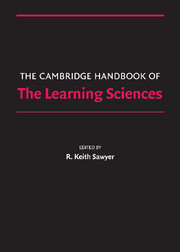Book contents
- Frontmatter
- Contents
- Preface
- Contributors
- 1 Introduction
- PART I FOUNDATIONS
- PART II METHODOLOGIES
- PART III THE NATURE OF KNOWLEDGE
- 14 Case-Based Reasoning
- 15 The Knowledge Integration Perspective on Learning and Instruction
- 16 A History of Conceptual Change Research
- 17 Spatial Representations and Imagery in Learning
- 18 Literacy and the Learning Sciences
- PART IV MAKING KNOWLEDGE VISIBLE
- PART V LEARNING TOGETHER
- PART VI LEARNING ENVIRONMENTS
- Afterword: After How Comes What
- Epilogue: The Fundamental Issue in the Learning Sciences
- Author Index
- Subject Index
- References
16 - A History of Conceptual Change Research
Threads and Fault Lines
Published online by Cambridge University Press: 05 June 2012
- Frontmatter
- Contents
- Preface
- Contributors
- 1 Introduction
- PART I FOUNDATIONS
- PART II METHODOLOGIES
- PART III THE NATURE OF KNOWLEDGE
- 14 Case-Based Reasoning
- 15 The Knowledge Integration Perspective on Learning and Instruction
- 16 A History of Conceptual Change Research
- 17 Spatial Representations and Imagery in Learning
- 18 Literacy and the Learning Sciences
- PART IV MAKING KNOWLEDGE VISIBLE
- PART V LEARNING TOGETHER
- PART VI LEARNING ENVIRONMENTS
- Afterword: After How Comes What
- Epilogue: The Fundamental Issue in the Learning Sciences
- Author Index
- Subject Index
- References
Summary
Characterizing Conceptual Change
Within the learning sciences, conceptual change is probably best defined by its relevance to instruction. In the broad educational experience, some topics seem systematically to be extremely difficult for students. Learning and teaching in these areas are problematic and present persistent failures of conventional methods of instruction. Many areas in the sciences, from elementary school through university level, have this characteristic, including, in physics, concepts of matter and density, Newtonian mechanics, electricity, and relativity; in biology, evolution and genetics. To learn such topics, students must go through a conceptual change. Conceptual change contrasts with less problematic learning such as skill acquisition and acquisition of facts, where difficulty may be evident, but for more apparent reasons such as sheer mass of learning, or the necessity of practice to produce quick, error free, highly refined performance.
The name “conceptual change” embodies a first approximation of what constitutes the primary difficulty: students must build new ideas in the context of old ones; hence, the emphasis on “change” rather than on simple acquisition. Strong evidence exists that prior ideas constrain learning in many areas. The “conceptual” part of the conceptual change label must be treated less literally. Various theories locate the difficulty in such entities as “beliefs,” “theories,” or “ontologies,” in addition to “concepts.”
- Type
- Chapter
- Information
- The Cambridge Handbook of the Learning Sciences , pp. 265 - 282Publisher: Cambridge University PressPrint publication year: 2005
References
- 22
- Cited by

